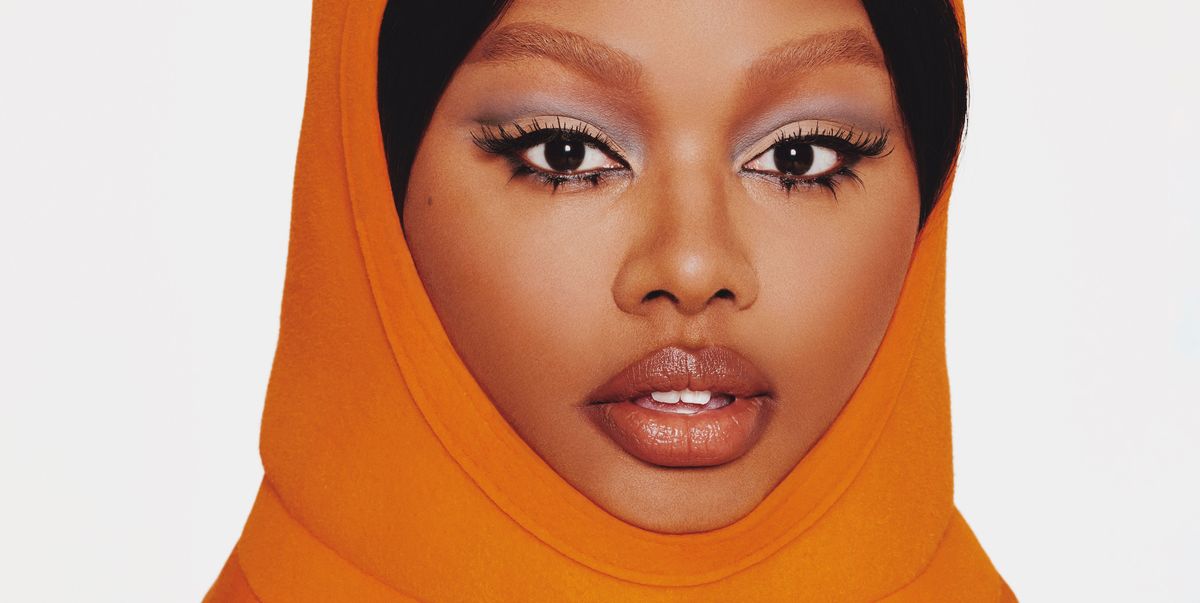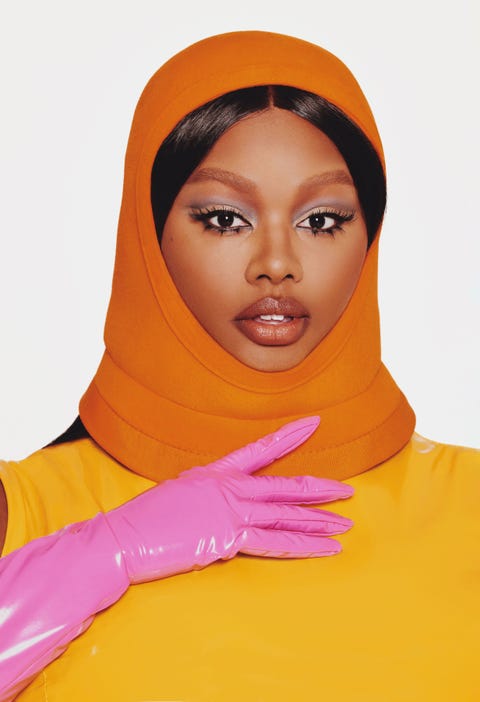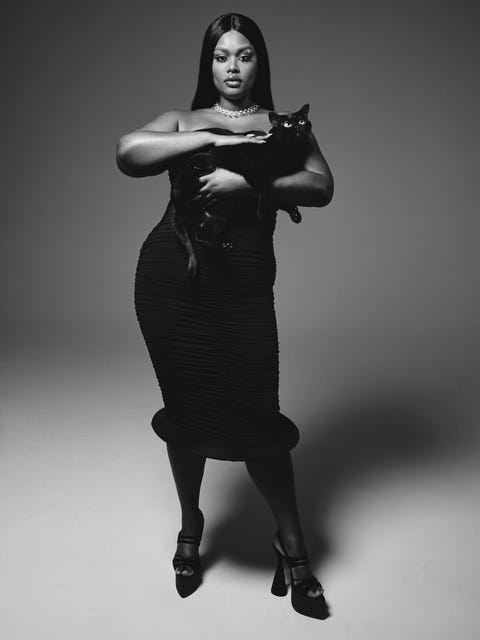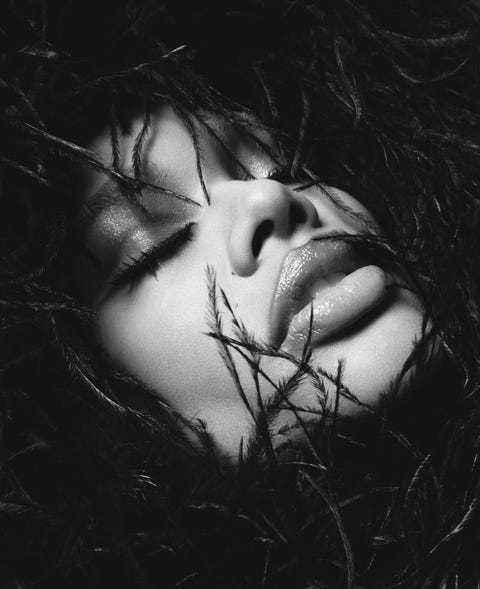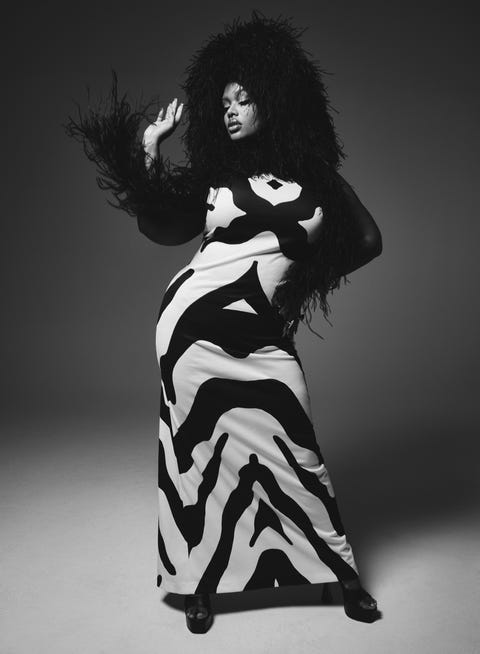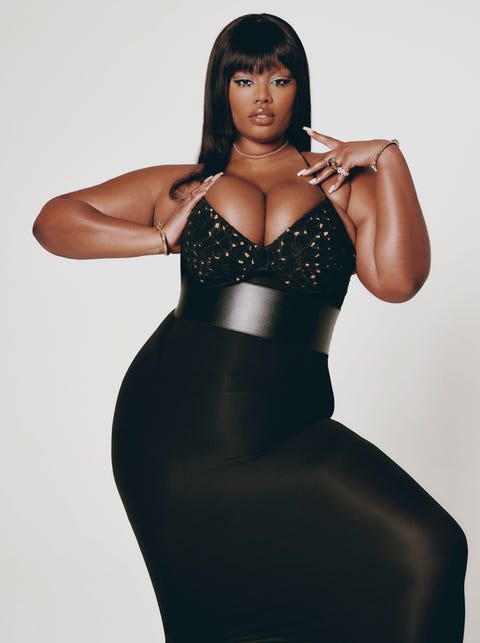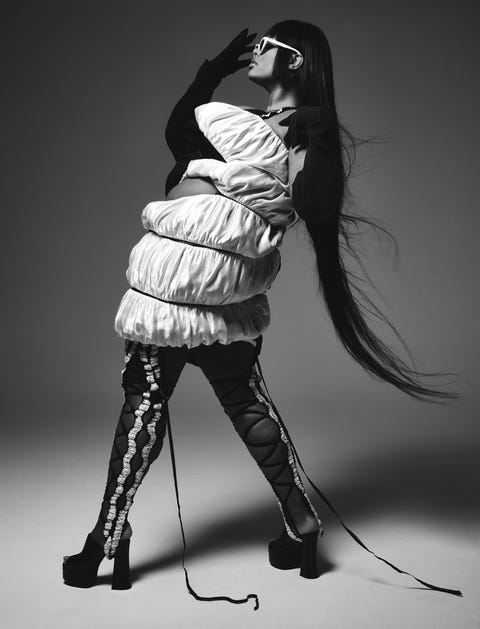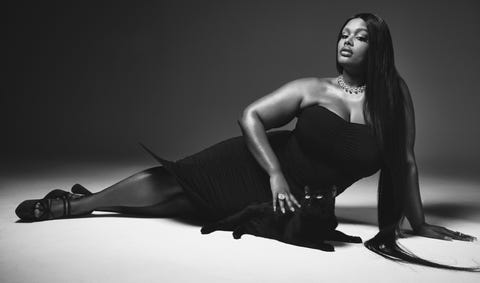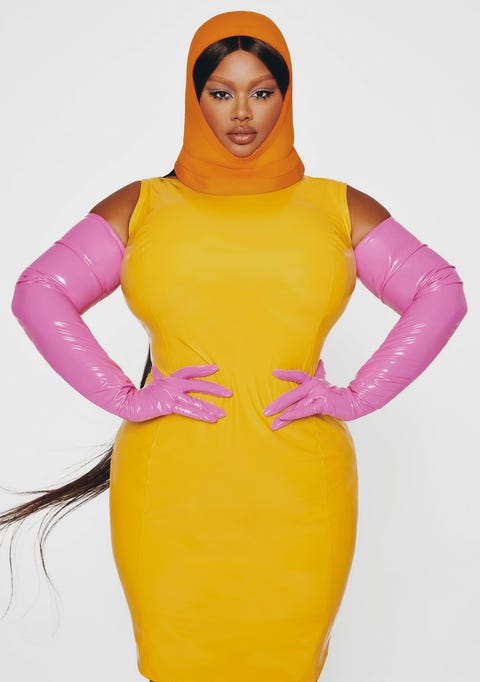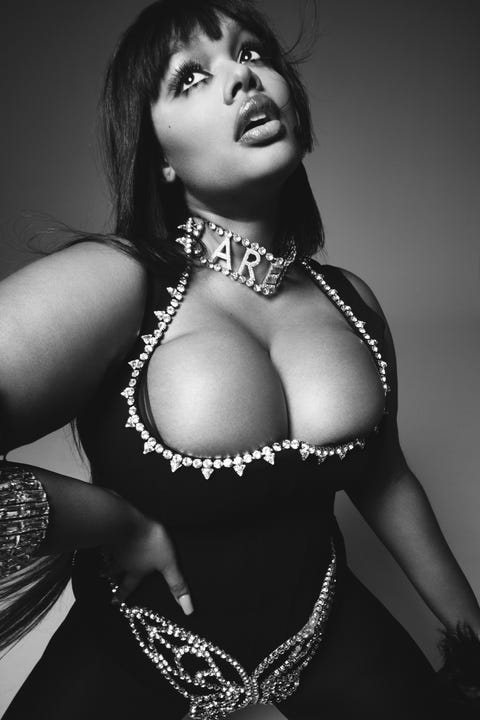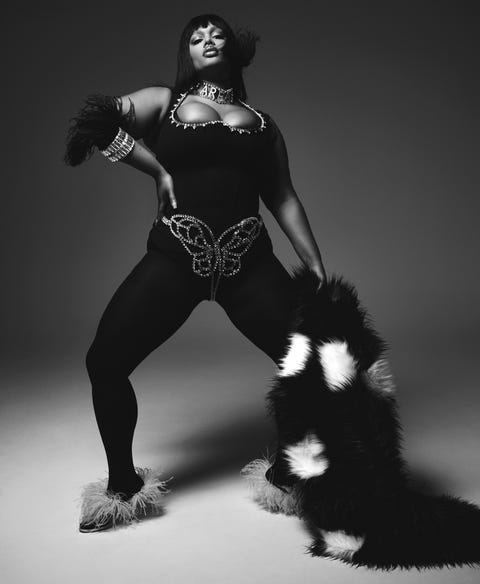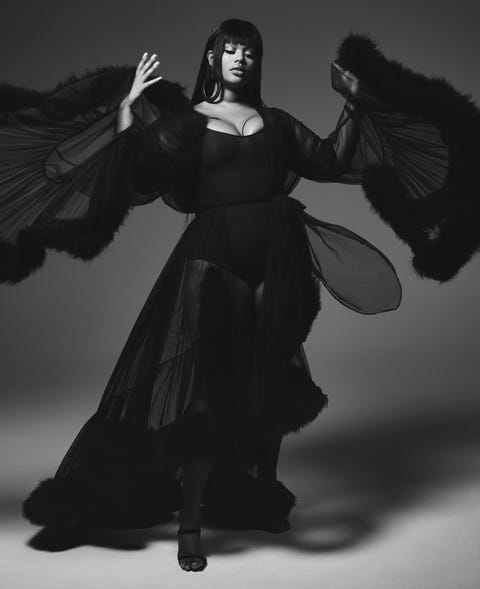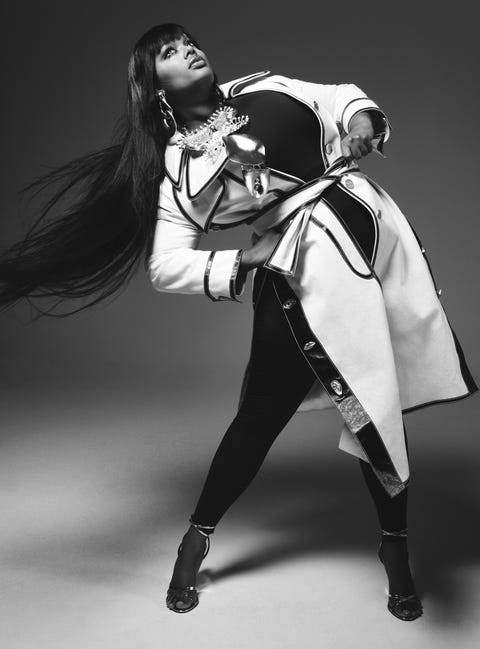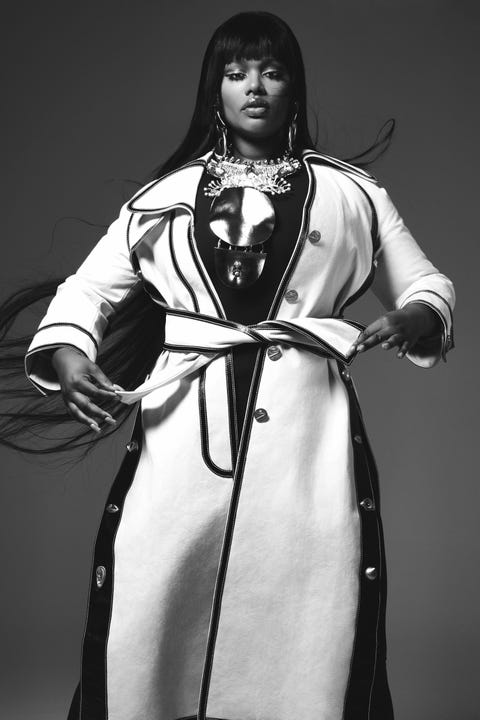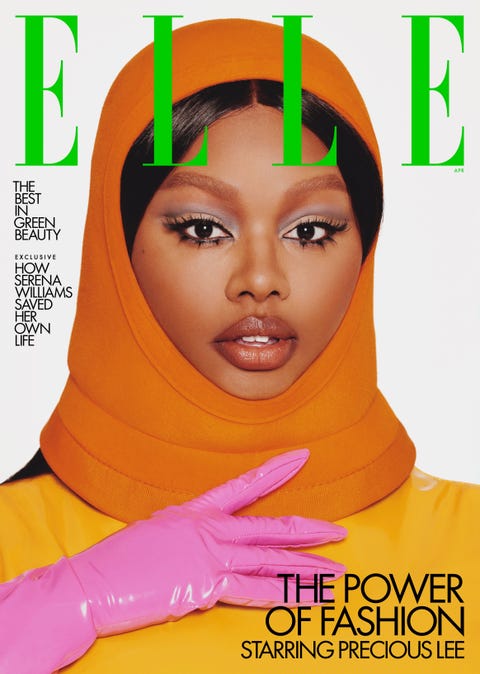You have to see Precious Lee up close to absorb her glow, an energy that is integral to her beauty. It’s been obvious, from her first editorials in store catalogs—where she posed like she was in a couture campaign—to her more recent presence on runways and magazine covers, that she’s a model the fashion industry wants to keep watching. The last few years have seen a dazzling rise for Lee, who belongs to the category of “curve models,” but who went from the typical domain of such mod-els—lingerie, swimsuits—to modeling the clothes of Versace, Fendi x Skims, and Moschino, proving again that high fashion can be sold to consumers with an array of body types. It’s a victory for a Southern Black woman who has continually resisted expectations of what she can and cannot do.
Not long before we first arranged to meet, Lee was in Atlanta, seeing family for the holidays. I’d been down South recently, too, visiting my Alabama hometown, about two and a half hours away from where Lee grew up. It was mostly sunny in both places, but now we’re sitting outside a New York restaurant with a heater hanging over us, a cold wind pushing against the table, and we’re freezing—well, I am.
She is somehow warm in a red crop top with extra-long sleeves by Hanifa and vintage denim under an open black Balenciaga leather coat with Margiela Tabi shoes. “I run hot,” Lee tells me, dropping her large quilted Telfar bag on the ledge beside us. Her black hair is long and straight, and her eyebrows are bleached blonde from a recent photo shoot. Lee and I are happy to discover our shared origins, despite the darkening gloom. “I love being from the South,” she says. “There’s something so warming from every person that you meet.”
Lee grew up in Atlanta, the child of two creative parents. Her mother, Anita, is a teacher, and her father, Rudy, is a cosmetologist and businessman who owned hair salons, among other companies. Both of them radiated glamour. Rudy wore Versace and “silk shirts unbuttoned with gold chains,” Lee says. People said he looked like a Black Elvis: “He had pretty much Elvis hair my whole life,” she adds. “He always had some big white car that he would pull up to the skating rink.”
Her uncle, Keith, performed as a drag queen and bought Dior for an infant Lee. She was encouraged to be creative, too. She put on concerts in the living room. “I was like, ‘Dad, hit the lights.’ He would dim the lights and I had this whole little showcase. I would do spoken word, I would sing,” she says.
Her mom pushed her to excel at school, while also letting her pick out elaborate outfits the night before. Their home was distinctive, too. “We had pink carpet. My childhood bed was like a California king round bed; it had this custom red velvet tufted headboard. My older sister Charisma had a waterbed,” Lee says. “One of my favorite rooms in the house was this funky living room we had, and it was all white. It had this mirrored bar.”
- BEAUTY TIP: Before applying lipstick, smooth and prime lips with Fenty BeautyPro Kiss’r LusciousLip Balm ($20).
But when Lee was young, Charisma died in a car accident. Lee was devastated, and became the only child at home; she had looked up to Charisma, who was in high school when she died, and with whom she would write and perform raps. “It was so much pain at that age from losing the brightest light,” Lee says. “I actually never talk about this in interviews, but it’s just really important to because I’m starting to realize and understand how transformative that age was for me in being able to tap into things that were creative as an outlet for healing for me.”
Her parents helped her get involved in activities to distract her from her grief. In grade school, she enrolled in competitive cheerleading, a sport that she says taught her “healthy competition.” At her first practice, the coach ran through everyone’s positions, and said that Lee would be a base, at the bottom of the pyramid, because of her height and size. But Lee was hurt and confused: Why wouldn’t she get a chance to show her skills first and potentially be a tumbler at the front of the pyramid?
So she stood up. “Something just came over me, and I just started doing every jump, and I did a roundoff into a split. And I was crying because I knew I was good,” Lee recalls. “[It was] my version of refusing to be put in a box. I was like, ‘There’s no way.’” When she finished, the coach came over to hug her, and said Lee would be at the front.
Lee also joined the Girl Scouts, participated in state science competitions, and made the dance team, among other activities. In high school, she played the flute and piccolo in concert band, and was a member of the debate and thespian clubs and the student government association. “She was a very active child, very present in the moment,” Anita tells me. “And she really inherited flair, which is instinctive in our family.” She adds, laughing, “She likes the finer things in life, and it’s our fault.” The two went to the ballet and to art museums when Lee was a girl; these days, Lee enjoys treating her mother, like when she took her to Saint Thomas in the U.S. Virgin Islands for her birthday.
Lee went on to study mass media arts at Clark Atlanta University, one of the country’s historically Black colleges and universities. I grew up on the campus of another HBCU—my dad taught at Alabama State University—and ask her if the experience was as heady as I imagine. “You have Spelman and Morehouse, where I cross-matriculated when I took my business course at Morehouse,” Lee says. “One of the best decisions ever. I loved the energy of just being around these damn super- confident, smart, powerful Black men, and me being myself completely.”
At Clark Atlanta, the style was thrilling; there was a sought-after fashion show every homecoming. Students treated a promenade that ran through campus like a runway. “You’re like, ‘Girl, you are in first-semester freshman year and you have on the new Chanel boots?’” Lee recalls.
Voted best-dressed as early as middle school, she was noticed for her looks in college and ended up walking in the homecoming show as a freshman. “It was nuts. You have all these super-fashionable kids who have all these crazy perspectives on fashion, and you get them in one space,” she says. The students producing the show gave every model a nickname, and Lee’s was Toccara, after the Black curve model who was a contestant on America’s Next Top Model.
Walking in the show, she says, gave her the “experience of feeling how magical it could be to represent so many people in that space, because even though it was a Black school, I was the only freshman curve model. I just remember feeling so inspired.”
Lee planned to go to law school, but during her freshman year of college, a friend persuaded her to go to an open call at a premier modeling agency in Atlanta. (“Do you know much they get paid?” her friend told her.) After the homecoming show, Lee could see how her aim of helping people as a lawyer could be partly realized through reflecting in fashion women who looked like her.
The agency signed her, and she was cast in commercial shoots throughout the Southeast. “I always came on set with that energy to give a picture and make a moment that was way beyond what we were supposed to do. I’m moving my hair. That wasn’t wind, that was me,” she says. “I knew I wanted Versace then.”
She took the LSAT, but after signing with Ford Models in New York during the second semester of her senior year, Lee moved to the city the same week she graduated from college. “That was one of the most spiritual decisions that I feel like I made in my adult life—to really take that leap,” she says. “To say I’m a full-time model after spending thousands of dollars on college. That is a huge risk. Especially being a size 12, 14. Having dark skin, not coming from nepotism. There were so many different things that were aligned for me to have ‘a struggle.’”
- BEAUTY TIP: For supple (but not sticky) skin, apply nourishing Fenty Skin Butta Drop Whipped Oil Body Cream with Tropical Oils +Shea Butter ($42).
But she felt she had to try, even if she was one of the only people, at the time, who could see her modeling couture. And even if she was committing to working in an industry where Black female bodies are either ignored or extremely visible and harshly judged—a magnification of the way society treats Black women. “I leaned into understanding and knowing like, ‘I know my power. You may not know my power yet,’” Lee says. “‘I don’t have to force you to see. You’re going to see it.’”
Her early days in the city could be challenging. She went to a casting meeting for a high-profile client; her agents told her the work would be lucrative if she were hired. While showing the casting representatives her portfolio, they asked her ethnicity. Lee said she was Black. They told her they had thought she was mixed-race because she was so pretty, and Lee, who was taken aback, said again that she was African American. The meeting soon ended.
Lee gets emotional thinking about that experience, and how she had refused to lie about her background to get the job. She had decided not to internalize the industry’s prejudices about Black beauty. “I have been real when it has not been to my immediate advantage,” she says.
But then she got the job: In the fall of 2020, Lee walked in Versace’s spring 2021 show in Milan, to a mostly virtual audience. “To be on set with Donatella—I felt like I was gliding. I could feel Charisma,” she says. She shot the brand’s campaign two days later and walked in its next two shows, along with the brand’s collaboration with Fendi. She has also attended the Met Gala—wearing a glittering, fringed suitdress by Area—and has worked with acclaimed fashion photographer Steven Meisel.
“The first time I met Precious, I immediately felt a pull,” Donatella Versace says. “Her laughter, the way she moves, the self-confidence, the way she embodies sensuality in her own way. Plus, she is very easy to work with: professional, kind. What more shall I add? I just adore her.”
Jeremy Scott, the designer behind Moschino, tells me that Lee came up to him at an Oscar party “prior to her explosion onto the fashion world” to tell him that she was a fan and wanted to work with him one day. “I was so entranced by her beauty, all I could manage to say over and over again was, ‘You’re sooo pretty.’ I was also inspired by the fact that her confidence is infectious!” he says. Her strengths, he goes on, are her ability to create characters for the camera and runway, and to give the “best hugs ever.”
Lee’s refusal to compromise her sense of worth makes her success feel even better. Her parents have encouraged her to take pride in herself since she was a girl. “Me being my size, me being my color—my mom painted our angels that were on the [Christmas] tree if she couldn’t find a Black one. She had a watercolor set that had brown colors, and she would literally paint the angel. She would paint Barbies that she couldn’t find to be my color,” she says. Lee, who recently guest-judged on an episode of Project Runway, and made her acting debut on the Starz series Run the World, tells me, “I’ve walked a runway with Naomi. As a size 14. Like, ‘What?’ I’m grateful it’s happening right now. I’m grateful it’s happening from my spirit.”
Hair by Evanie Frausto for Redken; Makeup by Raoúl Alejandre for Valentino Beauty; manicure by Mei Kawajiri for Dior Vernis.
This article appears in the April 2022 issue of ELLE.
